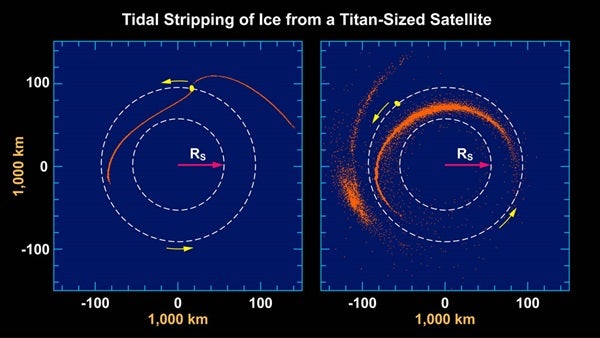Saturn’s rings are 90 to 95 percent water-ice. Because dust and debris from rocky meteoroids have polluted the rings, scientists believe the rings consisted of pure ice when they formed. This composition is unusual compared to the approximately half-ice and half-rock mixture expected for materials in the outer solar system. Similarly, the low densities of Saturn’s inner moons show that they, too, are unusually rich in ice.
The previous leading ring origin theory suggests the rings formed when an impacting comet disrupted a small satellite. “This scenario would have likely resulted in rings that were a mixture of rock and ice, rather than the ice-rich rings we see today,” said Robin M. Canup, associate vice president of the SwRI Planetary Science Directorate.
The new theory links the formation of the rings to the formation of Saturn’s satellites. While Jupiter has four large satellites, Saturn has only one, Titan. Previous work suggests that multiple Titan-sized satellites originally formed at Saturn, but those orbiting closer in than Titan were lost as their orbits spiraled into the planet.
As the final lost satellite neared Saturn, heating caused by the flexing of its shape by the planet’s gravity would cause its ice to melt and its rock to sink to its center. Canup used numerical simulations to show that as such a satellite crosses the region of the current B ring, planetary tidal forces strip material from its outer icy layers, while its rocky core remains intact and eventually collides with the planet. This produces an initial ice ring that is more massive than Saturn’s current rings.
Over time, collisions in the ring would cause it to spread radially and decrease in mass. Inwardly spreading ring material is lost, while material spreading past the ring’s outer edge accumulates into icy moons with estimated masses consistent with the inner moons seen today.
“The new model proposes that the rings are primordial, formed from the same events that left Titan as Saturn’s sole large satellite,” said Canup. “The implication is that the rings and the saturnian’s moons’ interior, to and including Tethys, share a coupled origin, and are the last remnants of a lost companion satellite to Titan.”
During its extended mission, the Cassini spacecraft will measure the rings’ current mass and will indirectly measure the pollution rate of the rings. This should provide an improved estimate of the rings’ age and a test of the new ring origin model.
Saturn’s rings are 90 to 95 percent water-ice. Because dust and debris from rocky meteoroids have polluted the rings, scientists believe the rings consisted of pure ice when they formed. This composition is unusual compared to the approximately half-ice and half-rock mixture expected for materials in the outer solar system. Similarly, the low densities of Saturn’s inner moons show that they, too, are unusually rich in ice.
The previous leading ring origin theory suggests the rings formed when an impacting comet disrupted a small satellite. “This scenario would have likely resulted in rings that were a mixture of rock and ice, rather than the ice-rich rings we see today,” said Robin M. Canup, associate vice president of the SwRI Planetary Science Directorate.
The new theory links the formation of the rings to the formation of Saturn’s satellites. While Jupiter has four large satellites, Saturn has only one, Titan. Previous work suggests that multiple Titan-sized satellites originally formed at Saturn, but those orbiting closer in than Titan were lost as their orbits spiraled into the planet.
As the final lost satellite neared Saturn, heating caused by the flexing of its shape by the planet’s gravity would cause its ice to melt and its rock to sink to its center. Canup used numerical simulations to show that as such a satellite crosses the region of the current B ring, planetary tidal forces strip material from its outer icy layers, while its rocky core remains intact and eventually collides with the planet. This produces an initial ice ring that is more massive than Saturn’s current rings.
Over time, collisions in the ring would cause it to spread radially and decrease in mass. Inwardly spreading ring material is lost, while material spreading past the ring’s outer edge accumulates into icy moons with estimated masses consistent with the inner moons seen today.
“The new model proposes that the rings are primordial, formed from the same events that left Titan as Saturn’s sole large satellite,” said Canup. “The implication is that the rings and the saturnian’s moons’ interior, to and including Tethys, share a coupled origin, and are the last remnants of a lost companion satellite to Titan.”
During its extended mission, the Cassini spacecraft will measure the rings’ current mass and will indirectly measure the pollution rate of the rings. This should provide an improved estimate of the rings’ age and a test of the new ring origin model.










